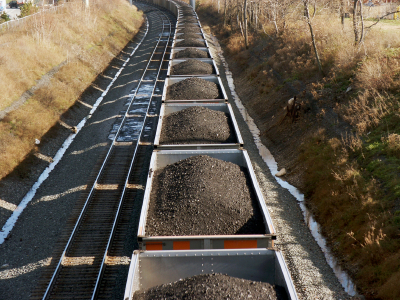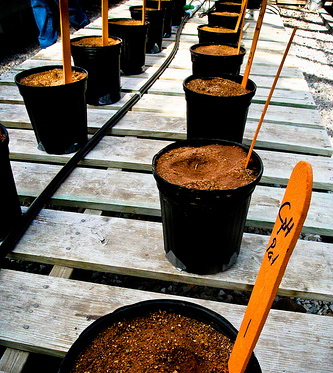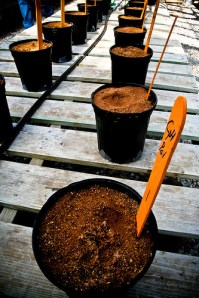
Photo by Jonathan Steffens.
I’m a phenomenal putter-offer, and getting my backyard soil tested is exactly the kind of chore I am fantastic at avoiding. It is the obvious, responsible thing to do, after all, but the results can be a punch in the gut to any urban farmer.
So I blindly ate my way through two growing seasons before curiosity compelled me to find out whether I was slowly consuming an enormous amount of lead and vintage Brooklyn arsenic.
After clearing our building’s backyard of waist-high weeds and an array of very upsetting litter (note the name of our “farm”), my boyfriend, our helpful friends, and I built three raised garden beds about two feet deep. We debated whether to seal the beds off before adding new soil, using pond liner or, preferably, some organic material, but decided it was unnecessary since we wouldn’t be growing anything with very deep roots.
Were we right, or just cheap and lazy? Maybe all of the above? Sometimes, the paranoid part of my brain plays me footage of all the scary shit in that pale, diseased, clumpy soil leaching its way into our moist, innocent dirt. In this imaginary film, the toxins seep up from under the wood frames of the beds, and up the stems of our precious plants. I’ve also tried to imagine our compost somehow fighting it off. And we do even have our own organic-fed chickens pooping nitrogen gold. What more could you need?
I scooped up some dirt from all three beds and brought it over to Brooklyn College, where Joshua Cheng runs the Environmental Sciences Analytical Center. I ordered their $75 advanced quality soil test, and asked him to talk me through the possible results. I told him my garden was in Bed-Stuy, and he said, “Yeah, that’s probably a bad area for lead, and I would expect a high frequency of contamination, like arsenic.”
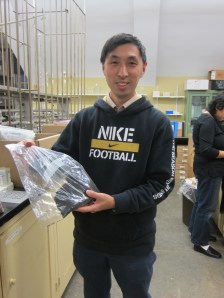
Joshua Cheng poses with soil samples at the Brooklyn University Environmental Sciences Analytical Center. (Photo by Nina Lalli.)
Not what I’m looking for, Josh! He casually explained that Bed-Stuy is near former industrial areas, like Bushwick, and the buildings are old, meaning they’re often flaking lead paint into the air and soil. Also, there’s a high possibility that pesticides made with arsenic are imbedded in the ground. “It kills bugs, it kills you,” said Josh.
I got particularly hung up on the lead. I know two Brooklyn mothers whose sons recently tested high for lead. They were worried about their sons’ health and stressed about whether New York would punish them as parents. (The state requires that children be tested for lead at ages 1 and 2, and doctors must report any blood test results over 10 micrograms per deciliter [mcg/dL ]).
Josh asked if I was feeding any small children my backyard produce, and said that developing brains are really the concern with lead. “Adults already have a lot of lead,” he shrugged. “Did you grow up in New York?” Yes I did. “In an old building?” Yup. “Well, then this isn’t really going to matter,” he said. Great, so the damage is already done.
Maybe if I hadn’t spent my babyhood in a pre-war building in Manhattan, in the early ’80s (when the acceptable lead level for babies was a whopping 40 mcg/dL), I would have turned out to be a Great Mind.
“Don’t worry too much,” Josh said. “You look pretty healthy.” I left my soil with him, in a lab full of samples that looked much worse than mine, a fact that made me feel a little better. I headed home to snort a few lines of lead and wash that down with some arsenic.
While I waited for my soil results, I looked into getting my own lead levels tested. Having no medical insurance, this became an amusing game of “No.” But I finally found a clinic in Chinatown that would see me in a timely fashion and on a sliding scale.
When I sat down with a doctor and told her why I was there, her eyes widened. “Are you experiencing lead poisoning symptoms? Do you work in an environment where you are exposed to a large amount of lead??” she asked. I explained that I was just doing it for research and out of deep self-involvement. She was a little perplexed, and said she didn’t have a lead test for adults. So, I got a regular blood test (I’m a little low on vitamin D), and a very bizarre free magazine explaining that before the Great Flood, humans regularly lived to be 900 years old. (No, really.)
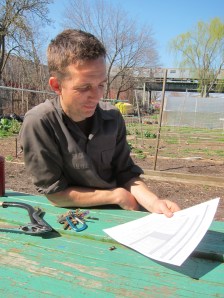
The East New York Farms' David Vigil explains the soil tests. (Photo by Nina Lalli.)
When my soil test came back, and I opened it eagerly, I found a lot of science I couldn’t comprehend. Brooklyn College sends helpful references along with the results, but I needed a human to break it down for me. So I scheduled a visit to East New York Farms, an inspiring organization with two urban farms, a farm stand, and a CSA. They also provide support for other community gardens, and I’m enamored of their work with young people and their focus on growing West Indian, Southern American, and Southeast Asian produce for the local population.
I sat down with David Vigil, the farms’ manager of six years, and he gave me his expert prognosis. To my surprise my soil’s lead level was only 63 parts per million (ppm), whereas the median listed in my area is 411 ppm. The organic content of my soil is high at 33 percent. My zinc is also a little high, which Vigil says is common in soil that has compost added to it. “It’s not ideal, but it’s not toxic,” he said. Arsenic came in at 5.9 ppm, which sounds like 5.9 too many, but the median number is 15 ppm and it turns out the range goes up to 79!
The N.Y. State Department of Environmental Conservation’s Soil Cleanup Objective allows 16 ppm of arsenic and 400 ppm of lead in soil meant for food growth. And, as David Vigil explains it, dust is by far the most dangerous form of lead. He also said he would be more comfortable eating food that was grown in lead-contaminated soil than vegetables grown in clean soil but housed in a space where lead particles were blowing around and possibly settling on the leaves of the plants themselves. Brooklyn College’s advice to gardeners points out that organic content (compost) can bind with lead and inhibit plants from absorbing it. They also recommend ground limestone as a way to reduce the availability of lead to plants.
So that’s all the new information that is crammed into my tiny, lead-infested brain. I’m relieved to know that my soil is relatively non-terrible, and I’m anxious to see how the next generation turns out, what with their fancy new lower lead levels and all.
See more stories from the Peebottle Farms series here.
